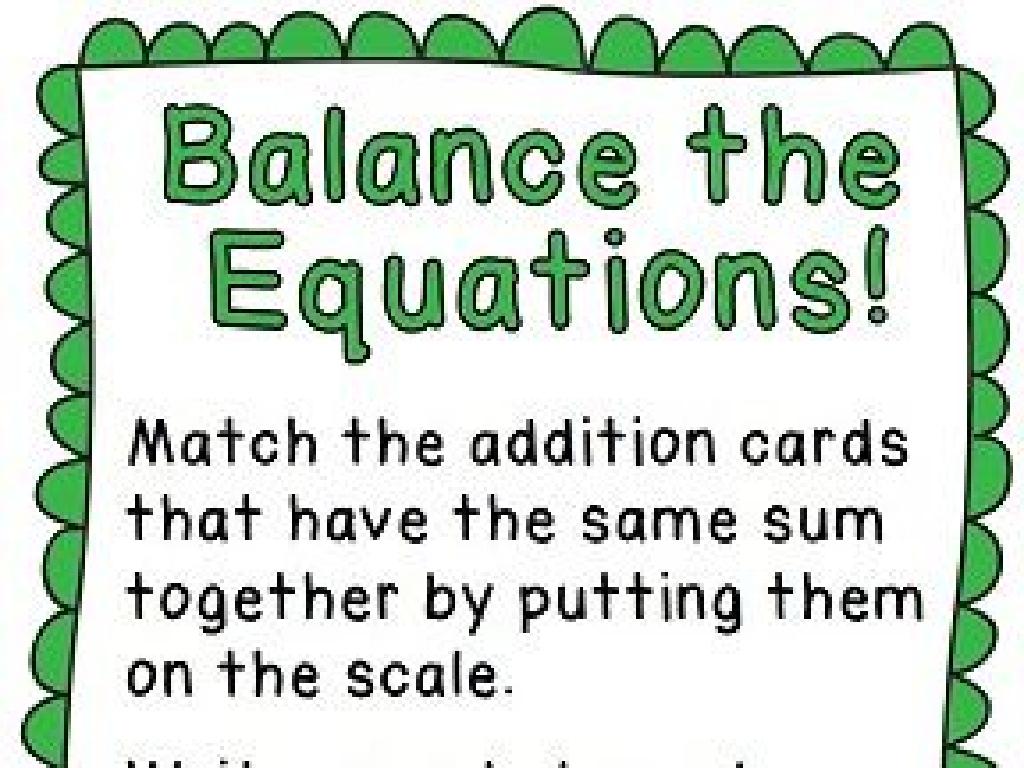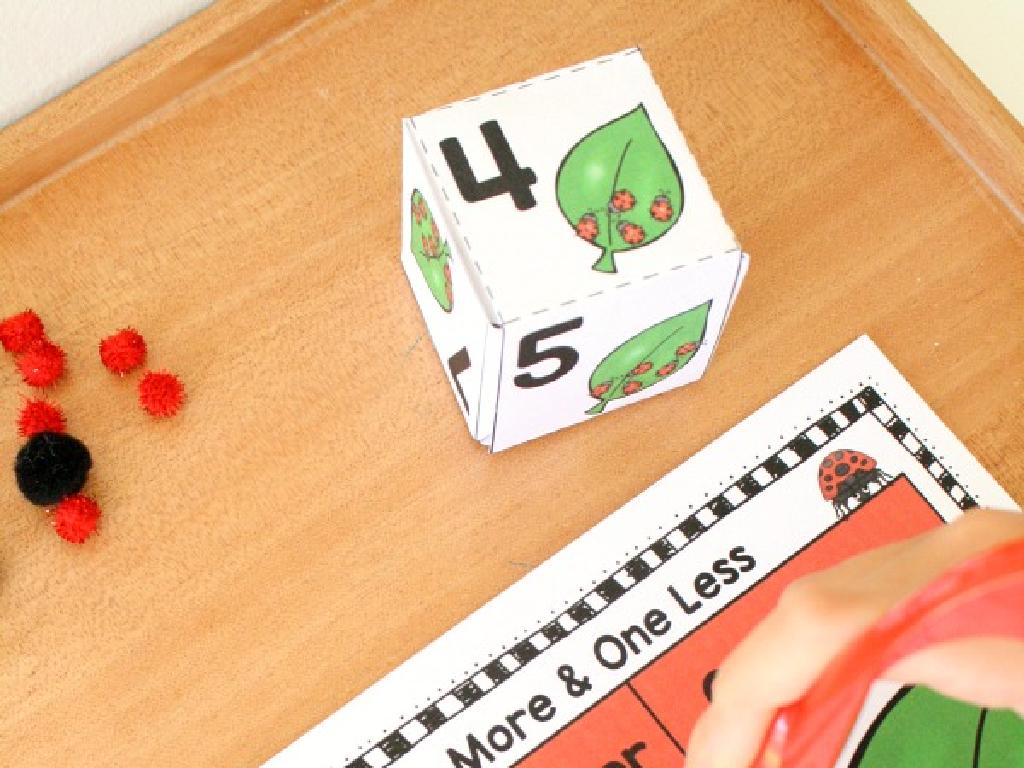Identify Active And Passive Voice
Subject: Language arts
Grade: Seventh grade
Topic: Active And Passive Voice
Please LOG IN to download the presentation. Access is available to registered users only.
View More Content
Active vs. Passive Voice
– Understanding sentence construction
– Active voice: subject performs action
– ‘The cat chased the mouse.’ The cat (subject) is doing the action.
– Passive voice: subject receives action
– ‘The mouse was chased by the cat.’ The mouse (subject) is not doing the action.
– Significance of voice in writing
– Knowing the difference enhances clarity and can affect the tone of your writing.
|
This slide introduces the concept of active and passive voice, which is crucial for students to understand sentence construction and improve their writing skills. Active voice is when the subject of the sentence performs the action, making the sentence clear and direct. Passive voice occurs when the subject is acted upon, which can be useful for emphasizing the action rather than the doer. It’s important for students to recognize the difference because it affects the clarity, conciseness, and tone of their writing. Encourage students to identify examples of each voice in their reading and practice converting sentences from passive to active voice and vice versa.
Understanding Active Voice
– Define Active Voice
– Active voice occurs when the subject of the sentence performs the action expressed by the verb.
– Subject performs action
– For instance, ‘The cat (subject) chased (verb) the mouse.’
– Examples of Active Voice
– ‘She writes a letter.’ ‘The teacher explains the topic.’
|
This slide introduces the concept of active voice, which is a fundamental aspect of English grammar. In active voice sentences, the subject is doing the action and is placed at the beginning of the sentence, followed by the verb. This structure emphasizes the subject’s role in the action. Provide clear examples to illustrate active voice. Encourage students to create their own sentences in active voice to reinforce their understanding. Discuss how active voice creates strong, direct sentences and is typically preferred in writing for clarity and engagement.
Understanding Passive Voice
– Define Passive Voice
– Passive Voice occurs when the subject receives the action.
– Subject’s role in Passive Voice
– The subject is the recipient of the action, not the doer.
– Examples of Passive Voice
– ‘The ball was thrown by John’ shows the ball (subject) receiving the action.
– Recognizing Passive Voice
– Clues: look for ‘by’ and verb forms like ‘was thrown’.
|
This slide introduces the concept of Passive Voice, which is a grammatical construction where the subject of the sentence is acted upon by the verb. It’s important to highlight that in Passive Voice, the subject is not performing the action but is receiving it. Use clear examples to illustrate how the subject’s role differs from that in Active Voice. Teach students to identify Passive Voice by looking for the verb ‘to be’ combined with a past participle and prepositions like ‘by.’ Discuss why an author might choose to use Passive Voice for emphasis or style. Encourage students to rewrite Passive Voice sentences into Active Voice to deepen their understanding.
Comparing Active and Passive Voice
– Identifying Active vs. Passive
– Active voice: subject performs action. Passive voice: subject receives action.
– Converting between voices
– Change the subject and verb placement and sometimes add ‘by’.
– Appropriate use of each voice
– Use active for clarity and passive for focus on the action or recipient.
– Practice with examples
|
This slide aims to help students distinguish between active and passive voice, a key skill in writing and grammar. Active voice is direct and clear, with the subject doing the action (e.g., ‘The cat chased the mouse.’). Passive voice emphasizes the action or the recipient of the action (e.g., ‘The mouse was chased by the cat.’). Teach students to convert sentences by rearranging the subject and verb and adding ‘by’ if necessary. Discuss when to use each voice, highlighting that active voice is generally preferred for its clarity, but passive can be useful when the action’s recipient is more important. Include practice sentences for students to identify and convert the voice type.
Active vs. Passive Voice: Usage
– When to use Active Voice
– Use active voice for direct, clear sentences.
– When to use Passive Voice
– Passive voice is useful when the action’s performer is unknown or unimportant.
– Effect on tone and clarity
– Active voice makes writing sound decisive; passive voice can be less clear.
– Examples in writing
– ‘The cat chased the mouse’ (active) vs. ‘The mouse was chased by the cat’ (passive).
|
This slide aims to help students understand the appropriate contexts for using active and passive voice in writing. Active voice is typically used to create straightforward and concise sentences where the subject performs the action. It’s often more engaging and clearer. Passive voice can be used when the focus is on the action itself rather than who or what is performing the action. It’s important to note that passive voice can sometimes lead to vagueness or a lack of clarity. Provide examples to illustrate the impact of voice on tone and clarity, and encourage students to identify and rewrite sentences in both voices for practice.
Let’s Practice: Active vs. Passive Voice
– Identify voice in sentences
– Determine if the subject is doing or receiving the action
– Convert passive to active
– Change ‘The ball was thrown by John’ to ‘John threw the ball’
– Convert active to passive
– Change ‘Maria sings a song’ to ‘A song is sung by Maria’
– Understand usage differences
|
This slide is designed for a class activity where students will practice distinguishing between active and passive voice in sentences. They will also practice converting sentences from passive to active voice and vice versa. It’s crucial to explain that in active voice, the subject performs the action denoted by the verb, while in passive voice, the subject receives the action. Encourage students to look for the ‘by’ phrase in passive sentences as a hint. Provide additional examples and guide them through the process of conversion, emphasizing the importance of understanding the subject’s role in a sentence. This activity will help solidify their grasp of sentence structure and enhance their writing skills.
Class Activity: Active and Passive Voice Hunt
– Pair up and find voice examples
– Look in magazines/newspapers for active and passive sentences
– Analyze the author’s choice of voice
– Discuss why the author might have used active or passive voice
– Prepare to present your discoveries
– Reflect on the use of different voices
– Think about how the voice affects the message
|
This activity is designed to help students identify and differentiate between active and passive voice in a practical context. By working in pairs, students will engage with real-life texts, fostering collaborative learning and critical thinking. Encourage them to consider the impact of the author’s choice of voice on the reader’s perception. Provide guidance on how to spot active voice (subject performs the action) and passive voice (subject receives the action). After the hunt, each pair will explain their findings, promoting public speaking and presentation skills. As a teacher, be prepared to offer examples and facilitate discussions on how voice can change the tone and clarity of a sentence.
Conclusion & Homework: Voices in Action
– Recap: Active vs. Passive Voice
– Active voice: subject performs action. Passive voice: subject receives action.
– Voice significance in writing
– Effective writing often requires choosing the right voice for clarity and impact.
– Homework: Craft a short story
– Write a story using what you’ve learned about voice.
– Incorporate both voice styles
– Use active voice for directness and passive voice when focus is on the action itself.
|
As we wrap up today’s lesson, remember that the active voice makes sentences clear and direct, while the passive voice is useful when the action is more important than who or what is performing it. For homework, students should write a short story that demonstrates their understanding of both active and passive voices. This will help reinforce today’s lesson and give them practical writing experience. Encourage creativity and remind them to indicate which sentences are active and which are passive to show their comprehension.






